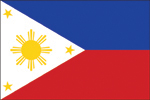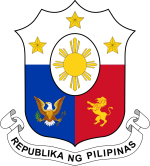 |
| The colouring of the map above highlights the three principal geographic divisions of the island chain. From north to south: Luzon, Visayas and Mindanao. |
The pre-colonial era saw inward migration from many places, leading to a diverse mix of peoples sometimes collectively called ‘Pinoy’. Originally a derogatory term, it is now coming into mainstream use.
The first colonialists were the Spanish, beginning when Spanish explorer Miguel López de Legazpi arrived from Mexico in 1565 and formed the first European settlements in Cebu. In 1571, after dealing with the local royal families and defeating the Chinese pirate warlord Limahong, the Spanish established Manila as the capital of the Spanish East Indies. It remains the country’s capital to this day.
Spanish rule continued until 1898, when the islands were ceded to the United States in consquence of the settlements arising from the Spanish-American War of that year. The Americans refused to recognise the pre-existing anti-Spanish independence movement and assumed the role of colonialists in disguise, labelling the country an “Insular Area” which they administered in a way broadly similar to the arrangements regarding governance of Puerto Rico today.
The repressive régime imposed by the Japanese invaders during World War Two ended with a return of US forces under the command of General Douglas MacArthur, a veteran of the defence of the islands in 1941/1942. Second time around, instead of governing, the Americans granted independence which was formally declared on July 4, 1946.
The recent history of the Republic has not been entirely without problems, involving dictatorship as well as democracy, and Islamist groups in the far south seeking independence.
Circumcision in the Philippines
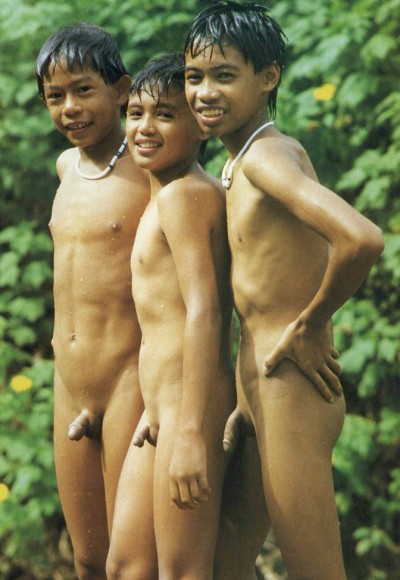
Circumcision in the Phillipines is an extremely ancient practice. The earliest settlers, the so called 'Negritos' (because of their dark skin colour), are related to indigenous Australians and have therefore been practising circumcsion for at least 60,000 years. The later settlers from Asia and Polynesia would also have mostly conformed to the custom. Curiously, unlike in Latin America, the Spanish conquistadores did not forbid the practice. By relatively modern times the procedure was typically a simple dorsal slit, as performed by many Polynesians and Melanesians. It took place at around age 10 (again as in Polynesia and Australia) and involved seclusion in the jungle.
Because of the risks of the traditional procedure, conventional circumcision, carried out by medical practioners, has now become more popular. The Phillipines does not have a free healthcare system but any number of organizations offer annual free circumcisions to those who cannot afford to pay. These take place in the traditional summer 'circumcision season'. A volcano eruption interfered with the 2019 season, and the 2020 season was cancelled because of the Covid pandemic. The service resumed, cautiously, in 2021, much to the relief of many boys. Reaching age 12 withou being circumcised is shameful to a Filipino boy.
Organisations within the country which run, or fund, the 'tule' or 'tuli' service, as it is called, include the Medical Corps of the Philippine Army, medical students, churches and local groups (similar to Rotary or Round Table). These mass circumcisions are often very public affairs, the whole village sometimes turning out to watch and photograph the proceedings.
The old and the new. The boy on the right has a modern medical circumcision while the middle boy has had a traditional dorsal slit. Note the bunch of surplus skin below his glans. Not clear about the boy on the left. Photo from the French nudist magazine Jeunes et Naturels.
"Operation Tule" - mass circumcisions |
|
|---|---|
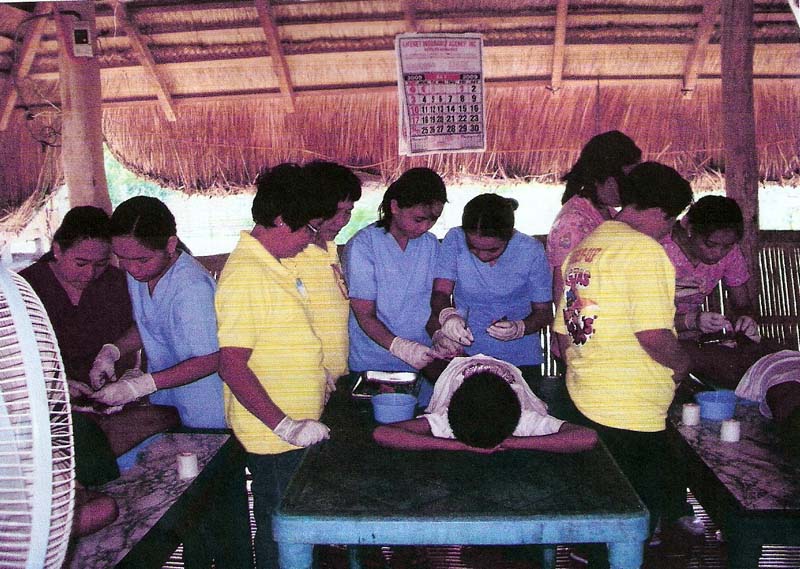 |
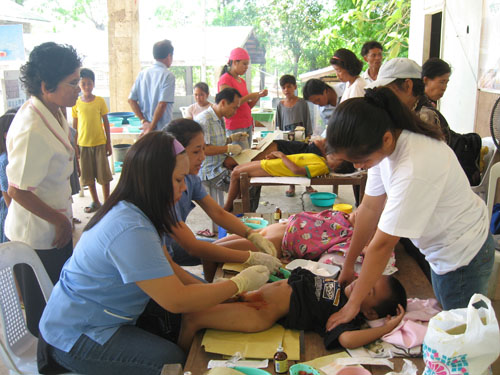 |
| Image © 2007, Visayas Primary Health Care Services, Inc. |
The generally easy-going nature of the population is reflected in their openness towards the issue of circumcision, which can without embarrassment be depicted in public art, as in this whimsical mural by the Filipino artist Reynold Dela Cruz.
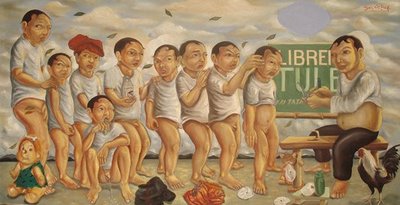
Correspondence
Local experience across 2 generations
I would like to share my experience that Filipino boys age 7 to 10 years old are often circumcised in a group during summer time by a traditional circumciser using dorsal slit method that takes only few seconds and is done without anesthesia. They don’t mind this being seen by others kids. Probably one thing nice about Filipinos being circumcised is that they chose it. The parents are sometimes greatly surprised when they find out that their son had themselves cut.
I guess the significance of being circumcised or intact greatly depends on the place where you live and what is considered the norm for a particular group of people living together.
When I was 7 or 8 years old, I really felt that I should be circumcised since all the males around me were circumcised. At that time I believed being circumcised to be macho and I was afraid to be called sissy. I myself didn’t have problems with hygiene since my uncircumcised cock didn’t smell at all.
It was not until I reached the age of twenty that I had the courage to go to the doctor and have myself circumcised. After my circumcision, I do still believe that being circumcised is basically a matter of social acceptance because if you don’t, you will be ridiculed here in the Philippines.
For this reason I have had my two sons circumcised. My eldest was done at birth and my second son was circumcised at 10 years old. I realized that my second son enjoyed more and he is happier compared to my eldest because he has experience as a child how shameful he was not to be accepted by his classmates and friends just because he was uncut.
I believe that what dictates one to be circumcised or not is his personal preference, social acceptability and medical necessity.
Phil
Meeting a Filipino
During the recent holidays, my friend brought with him a 22 year old Filipino guy. We were talking about how painful some things are, and my friend announced that Carlo knew how to handle pain as he had been circumcised when he was 12 years old. Carlo was rather embarrassed abou this announcement. He confirmed that it was his people’s custom to circumcise boys when they were 12 and to do this in the ritual way. He said that his foreskin was drawn forward, the skin ‘chopped’ with a quick blow of a knife and he was told to run into the cold ocean. He said it hurt for a while, but wasn’t that bad.
His circumcision left lots of inner foreskin lining, as you might imagine, but removed a significant part of the outer skin leaving him with a moderately tight circumcision. The frenulum is completely intact, and the circ scar is straight. It was an overall pleasing circumcision.
His little brother (5 years younger than him) was circumcised the same way just five years ago. He also said that more and more Filipino families are having their sons circumcised at birth, or circumcised when they are 12 in the doctor’s office.
Anon
An historical opinion
The Filipinos were under Islamic rule when Spain took over. Magellan was killed by a Muslim chieftain. Under Islam any uncut guy that resisted conversion was to be killed. When Spain took over they were unable to convince the locals to stop the practice of circumcision which was at the time illegal in Spain and the ‘new world’. Any Spanish citizen found practicing any form of Islamic or Jewish religious practice after baptism was tortured and then burned at the stake.
The practice of circumcision nevertheless continued in the Philippines. The locals justified it as being a Christian thing (Jesus was of course Jewish), evidenced by the feast of the circumcision being celebrated on the first day of January.
Not all Filipinos now practice circumcision, but it is undoubtedly done to the majority of males usually about the time of puberty. Many are now doing it to infants now too. Those of pure Chinese or Spanish ancestry don’t usually cut, but the people of local ancestry or mixed background mostly do circumcise.
Anon
Now living in the USA...
I am a Filipino male, who was circumcised at age nine. I have to tell you that all Filipino males are circumcised, anyone who is not will be teased to kingdom come. Most boys in the Philippines are circumcised at age nine, or when they get to the fourth grade. It seems that the Filipinos put a lot of importance on this practice which, for many males, is their rite of passage from childhood to adulthood. The circumcised young man is now able to show off his cut dick, by being able to shower with the rest of the guys in public baths or having their first taste of sex. Filipina women know for a fact that a boy/man should be circumcised, so they definitely know what to expect when they see the male genitalia. God help the guy who is not cut, for he will forever be the butt of jokes among his peers and lady friends.
Romy - now in New York, USA
Copyright © 1992 - 2022, All Rights Reserved CIRCLIST.
